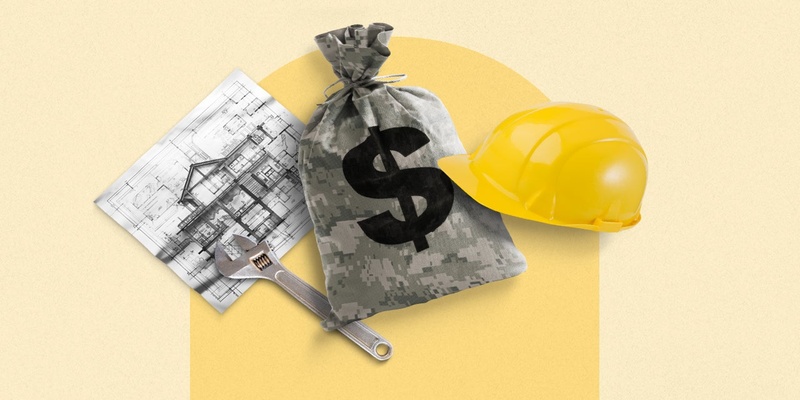VA construction loans are quick loans that help you pay for building a new house. You can use it once, twice, three times, or seven times rather than all at once.
Usually, you can always apply for another VA loan as long as you have a spare entitlement. If you need help getting the money to build the house of your dreams, a Virginia construction loan may be an intelligent choice, including the land it will be made on.
It ensures you multiple benefits from several things, such as not needing to pay PMI (private mortgage insurance) and not needing a down payment, which a conventional construction loan might require.
This article will help you with the VA construction loan guide: everything you need to know to build the home of your dreams. Let’s start!
What Is A VA Construction Loan?
VA construction loans serve specifically for the purchase of property and the construction of a new primary house. After construction, this short-term financing option will convert into a permanent VA loan.
However, this loan differs from the more popular VA purchase loan, which is meant to purchase an already-owned house.
Instead, you can pay for building your home and buying the lot with the profits from your loan.
If you have any of the following military service backgrounds, you may be qualified:
- Active duty status as of right now (National Guard and Reserve troops can also qualify)
- Retired without receiving a derogatory discharge
- Spouse of a veteran still living
Aside from this, the lender will set additional criteria, including a minimum debt-to-income (DTI) ratio or qualifying credit score.
Remember, though, that not all VA lenders provide loans for buildings. As a result, you might need to take more time to locate a participating lender.
The Process of a VA Construction Loan

Here's how you can use a VA loan to build a house.
Obtain a Building Plan Approved
Your builder and VA-approved lender will cooperate with you to complete the financing and building plan. Usually, the first underwriting procedure takes 45 to 60 days.
Lenders for VA construction loans could provide you with two lending choices. How many mortgage closings you have and when the VA financing fee is due depend on the type of loan you have
One-time Close
A construction-to-permanent loan covers your final payment terms and building costs in one loan. Before construction starts, your VA financing fee may become due within 15 days of the original closure.
Two-time Close
There will be two closing dates for your separate construction and permanent loans. When the building is finished, the second closure will occur.
According to VA requirements, you usually have a year from the closing date until lenders start collecting mortgage payments.
Entire House Construction
At every stage of construction, contractors receive the required payments, also known as draws.
To ensure financial transparency, your lender does not give you the money.
Instead, they release this cash directly to the builder from an escrow account. Although you don't have to handle the money, you must give the lender written consent before making any draws.
Switching to a Permanent Loan
After your home is inspected, you can convert your construction loan into a permanent one without difficulty. If you want to keep using a VA loan, you can go for a purchase loan or a cash-out refinance.
Basic Requirements To Get VA Construction Loans
Make sure you follow these VA loan regulations before you begin construction:
Certificate of Eligibility (COE)
A COE is required before you apply for a house loan from VA. The VA sets no minimum credit score restrictions. However, they frequently demand a minimum FICO score of 620.
Low DTI ratio
Lenders may also require a DTI of less than 45% or 50%. You should be eligible for better VA construction loan rates if your DTI is lower.
Proof of Income
To confirm your income for the past two years, you should provide recent pay stubs, tax returns, W2s, and bank statements.
Registered Build
The work needs to be finished by VA-registered builders. Additionally, the lenders may require the builder's or contractor's license, bond, and insurance. The VA keeps a record of builders for whom you need assistance.
Origination Appraisal
The proposal must meet local building codes and the VA's Minimum Property Requirements (MPRs). For you to be eligible, this house cannot be a second permanent residence or an investment.
How To Apply For VA Construction Loans

Following these steps, you can effectively identify a lender offering construction loans backed by the VA:
- Assemble the necessary paperwork
- Gather all of the income and credit documentation lenders
- Submit your Certificate of Eligibility (COE) to confirm your service status.
- Get Preapproval for a Loan
Next, find a credit union or bank that provides VA loans. This search process will take longer than a house purchase loan since not all VA lenders offer construction loans.
After approval, determining your borrowing VA construction loan limits might help determine how much money you have available to purchase land and construct a reasonably priced home.
Comparing rates offered by multiple lenders is crucial to getting the best mortgage rates and terms for your project.
2 Essential Steps For VA Construction Loan Approval

Submit the Building Plan
You can submit your home proposal for approval once you find a builder registered with the VA.
Your maximum loan amount,
Your eligibility for a $0 down payment and whether the house satisfies the minimum property requirements are all determined by this initial VA assessment.
Sign the Final Form
You can settle your payment conditions once the lender has approved your development project. This change will help you determine the overall cost of your loan and the payback terms.
When it comes time to move into your new house, ask your lender how to convert your construction loan into a permanent loan.
Before you start construction, you should have a strategy to avoid unpleasant financial circumstances afterward.
Conclusion
That is all you need to know about VA construction and permanent loan guidelines. Undoubtedly, It is a priceless tool that will help you understand the difficulties of funding for home construction by providing simple information.
It will give you instructions and directions that will enable you to make wise choices, making achieving your ideal home even more accessible. Hopefully, our “VA Construction Loan Guide: Everything You Need To Know” will satisfy all your queries!

How To Switch Financial Advisers

Brewing Rebellion: The Boston Tea Party After 250 Years

How to Get Rid of a Timeshare: A Comprehensive Guide

Deciphering Credit Cards: A Step-by-Step Guide

View Authorized User Purchases

Wells Fargo's Cell Phone Insurance

The Future of Corporate Taxes: A Critical Look Beyond Short-Term Gains

A Brief Guide: What Are Peer-to-Peer Payments?

Comparing Citi Custom Cash vs. Chase Freedom Flex: Which Credit Card Is Right for You?

How an Auto Loan Grace Period Can Save You From Late Fees?

Do You Know: What Is A Mortgage Recast?
